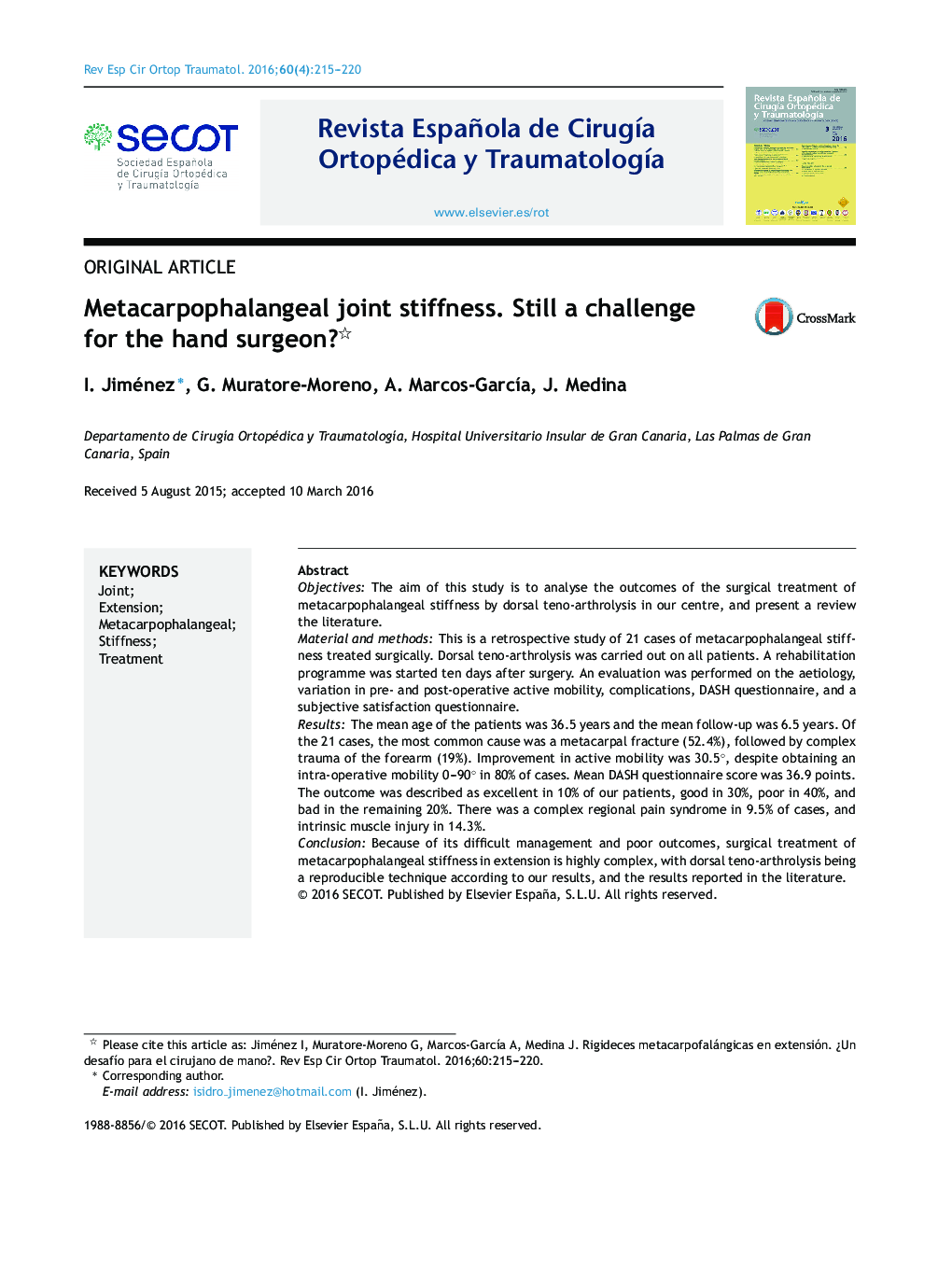| کد مقاله | کد نشریه | سال انتشار | مقاله انگلیسی | نسخه تمام متن |
|---|---|---|---|---|
| 4087053 | 1268011 | 2016 | 6 صفحه PDF | دانلود رایگان |
ObjectivesThe aim of this study is to analyse the outcomes of the surgical treatment of metacarpophalangeal stiffness by dorsal teno-arthrolysis in our centre, and present a review the literature.Material and methodsThis is a retrospective study of 21 cases of metacarpophalangeal stiffness treated surgically. Dorsal teno-arthrolysis was carried out on all patients. A rehabilitation programme was started ten days after surgery. An evaluation was performed on the aetiology, variation in pre- and post-operative active mobility, complications, DASH questionnaire, and a subjective satisfaction questionnaire.ResultsThe mean age of the patients was 36.5 years and the mean follow-up was 6.5 years. Of the 21 cases, the most common cause was a metacarpal fracture (52.4%), followed by complex trauma of the forearm (19%). Improvement in active mobility was 30.5°, despite obtaining an intra-operative mobility 0–90° in 80% of cases. Mean DASH questionnaire score was 36.9 points. The outcome was described as excellent in 10% of our patients, good in 30%, poor in 40%, and bad in the remaining 20%. There was a complex regional pain syndrome in 9.5% of cases, and intrinsic muscle injury in 14.3%.ConclusionBecause of its difficult management and poor outcomes, surgical treatment of metacarpophalangeal stiffness in extension is highly complex, with dorsal teno-arthrolysis being a reproducible technique according to our results, and the results reported in the literature.
ResumenObjetivoAnalizar los resultados obtenidos en el tratamiento quirúrgico de la rigidez metacarpofalángica en extensión mediante tenoartrólisis dorsal en nuestro centro y revisar la literatura al respecto.Material y métodoEstudio retrospectivo de 21 rigideces metacarpofalángicas intervenidas. En todos los pacientes se realizó tenoartrólisis dorsal de forma ambulatoria, comenzando la rehabilitación a los diez días postoperatorios. Se registró etiología, variación de la movilidad activa tras la cirugía, complicaciones, cuestionario DASH y una encuesta de satisfacción con el resultado.ResultadosEl seguimiento medio fue de 6,5 años y la edad media de 36,5 años. La causa más frecuente fue la fractura de un metacarpiano (52,4%) seguida de los traumatismos complejos de antebrazo (19%). A final del seguimiento la mejoría en la movilidad activa fue de 30,5° pese a obtener una movilidad intraoperatoria de 0-90° en más del 80% de los casos. En el cuestionario DASH la puntuación media fue de 36,9, calificando el resultado como excelente el 10% de nuestros pacientes, bueno el 30%, regular el 40% y malo el 20% restante. En el 9,5% de los casos se produjo un síndrome de dolor regional complejo y en el 14,3% lesión de la musculatura intrínseca.ConclusiónPor su difícil abordaje y pobres resultados, el tratamiento quirúrgico de la rigidez metacarpofalángica en extensión es de gran dificultad mostrándose la tenoartrólisis dorsal como una técnica reproducible en relación con nuestros resultados y a los resultados publicados en la literatura.
Journal: Revista Española de Cirugía Ortopédica y Traumatología (English Edition) - Volume 60, Issue 4, July–August 2016, Pages 215–220
